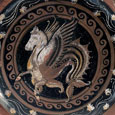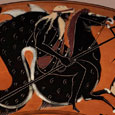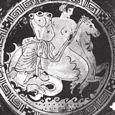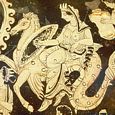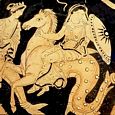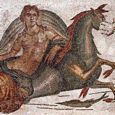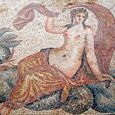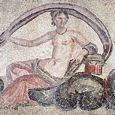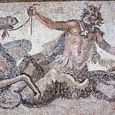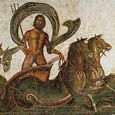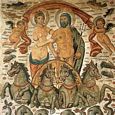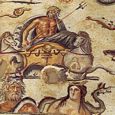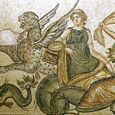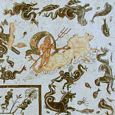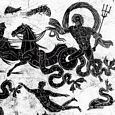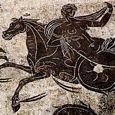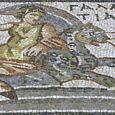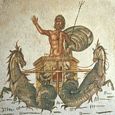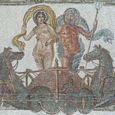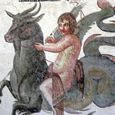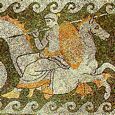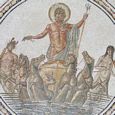HIPPOKAMPOI
Greek Name
Ἱπποκαμπος
Ἱπποκαμποι
Transliteration
Hippokampos
Hippokampoi
Latin Spelling
Hippocampus
Hippocampi
Translation
Crooked Horse
(kampos, hippos)
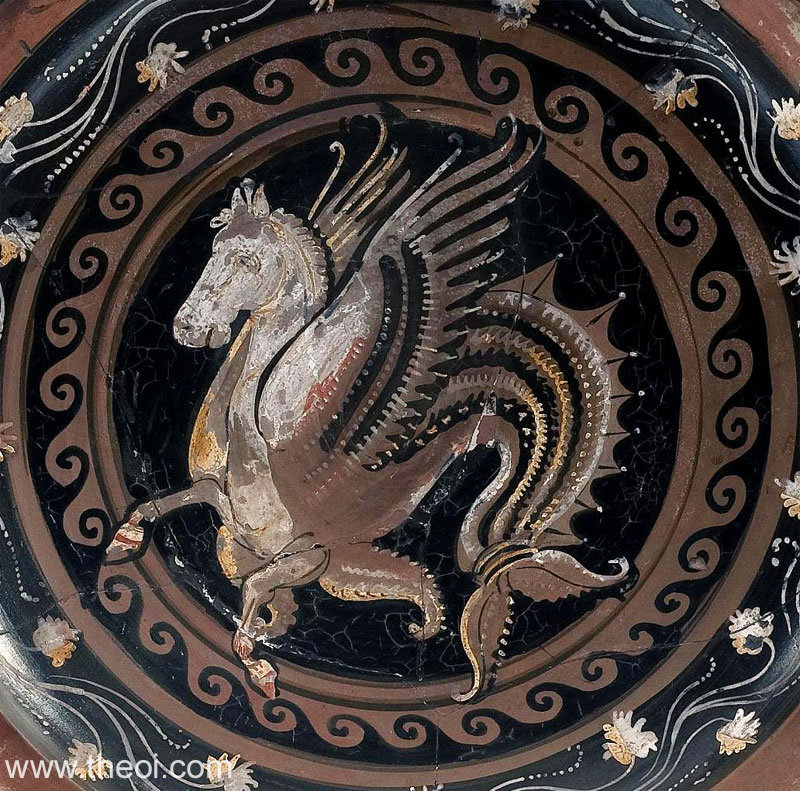
HIPPOKAMPOI (Hippocamps) were the fish-tailed horses of the sea. They were depicted as composite creatures with the head and fore-parts of a horse and the serpentine-tail of a fish. In mosaic art they were often had green scales and fish-fin manes and appendages.
The ancients believed they were the adult-form of the small fish we call the "sea-horse". Hippokampoi were the mounts of Nereid nymphs and sea-gods, and Poseidon drove a chariot drawn by two or four of the creatures.
Other fish-tailed land animals which appear in ancient art include the "Leokampos" (fish-tailed lion), "Taurokampos" (fish-tailed bull), "Pardalokampos" (fish-tailed leopard), and "Aigikampos" (fish-tailed goat). The last was the form of the constellation Capricorn. Fabulous creatures of this type were believed to be common in the Indian Ocean (see Ketea Indikoi).
ENCYCLOPEDIA
HIPPOCAMPE and HIPPOCAMPUS (Hippokampê and Hippokampos), the mythical sea-horse, which, according to the description of Pausanias (ii. 1), was a horse, but the part of its body down from the breast was that of a sea monster or fish. The horse appears even in the Homeric poems as the symbol of Poseidon, whose chariot was drawn over the surface of the sea by swift horses. The later poets and artists conceived and represented the horses of Poseidon and other marine divinities as a combination of a horse and a fish. (Hom. Il. xlii. 24, 29; Eurip. Androm. 1012; Virg. Georg. iv. 389; Philostr. Imag . i. 8; Stat. Theb. ii. 45.)
Source: Dictionary of Greek and Roman Biography and Mythology.
CLASSICAL LITERATURE QUOTES
Apollonius Rhodius, Argonautica 4. 1533 ff (trans. Rieu) (Greek epic C3rd B.C.)
:
"[Jason addresses the Argonauts as they port their ship across the Libyan desert :] ‘They [the
Nymphai (Nymphs) of Lake Tritonis in Libya] said that when Amphitrite had unyoked the horses from Poseidon's
rolling chariot we were to recompense our mother [the ship Argo] amply for what she had suffered all the long
time she bore us in her womb. Now I admit that the meaning of this oracle eludes me . . .’
The Minyai [Argonauts] listened with amazement to his tale. It was followed by the most astounding prodigy. A
great horse came bounding out of the sea, a monstrous animal, with his golden mane waving in the air. He shook
himself, tossing off the spray in showers. Then, fast as the wind, he galloped away.
Peleus was overjoyed and at once explained the portent to the others. ‘It is clear to me,’ he said,
‘that Poseidon's loving wife has just unyoked his team. As for our mother, I take her to be none but the
ship herself. Argo carried us in her womb; we have often heard her groaning in her pain. Now, we will carry her.
We will hoist her on our shoulders, and never resting , never tiring, carry her across the sandy waste in the
track of the galloping horse. He will not disappear inland. I am sure that his hoofprints will lead us to some
bay that overlooks the sea.’" [N.B. The horse probably reaquired its fish-tail when it returned to
the sea.]
Strabo, Geography 8. 7. 2 (trans. Jones) (Greek geographer C1st B.C. to C1st A.D.)
:
"The sea was raised by an earthquake and it submerged Helike (Helice) [in Akhaia (Achaea)], and also the
temple of Poseidon Helikonios (of Helike) . . . And Eratosthenes [C3rd B.C. poet] says that he himself saw the
place, and that the ferrymen say that there was a bronze Poseidon in the strait, standing erect, holding a
Hippokampos (Hippocamp) in his hand, which was perilous for those who fished with nets."
Pausanias, Description of Greece 2. 1. 7 - 9 (trans. Jones) (Greek travelogue C2nd
A.D.) :
"[In the temple of Poseidon in Korinthos (Corinth) :] The other offerings are images of Galene (Calm) and
of Thalassa (Sea) and a horse like a whale (ketos) from the breast onwards [i.e. a Hippokampos
(Hippocamp)]."
Philostratus the Elder, Imagines 1. 8 (trans. Fairbanks) (Greek rhetorician C3rd
A.D.) :
"[From a description of an ancient Greek painting in Neapolis (Naples) :] Poseidon's journey over the sea I
think you have come upon in Homer, when he sets forth from Aigai (Aegae) to join the Akhaians (Achaeans), and
the sea is calm, escorting him with its Sea Horses and its Ketea (Cetea, Sea-Monsters); for in Homer they follow
Poseidon and fawn upon him as they do here in the painting. There, I imagine, your thought is of dry-land
horses--for Homer maintains that they are ‘bronze-hoofed,’ ‘swiftly-flying,’ and
‘smitten by the lash’--but here it is Hippokampoi (Hippocamps) that draw the chariot, creatures with
web-footed hoofs, good swimmers, blue-eyed, and, by Zeus, in all respects like dolphins."
Valerius Flaccus, Argonautica 2. 507 ff (trans. Mozley) (Roman epic C1st A.D.)
:
"Orion when grasping his father's [Neptune-Poseidon's] reins he heaves the sea with the snorting of his
two-hooved horses [Hippokampoi (Hippocamps)]."
Statius, Thebaid 2. 45 ff (trans. Mozley) (Roman epic C1st A.D.) :
"There [at Cape Tainaros (Taenarum) at the southern end of the Peloponnese] Neptunus [Poseidon] brings hom
to haven his coursers wearied by the Aegean flood; in front their hooves paw the sand, behind, they end in fishy
tails beneath the water."
Statius, Achilleid 1. 25 ff :
"He [Poseidon] towers on high above the peaceful waves, urging his team [of Hippokampoi (Hippocamps)] with
his three-pronged spear: frontwise they run at furious speed amid showers of foam, behind they swim and blot out
their footprints with their tails."
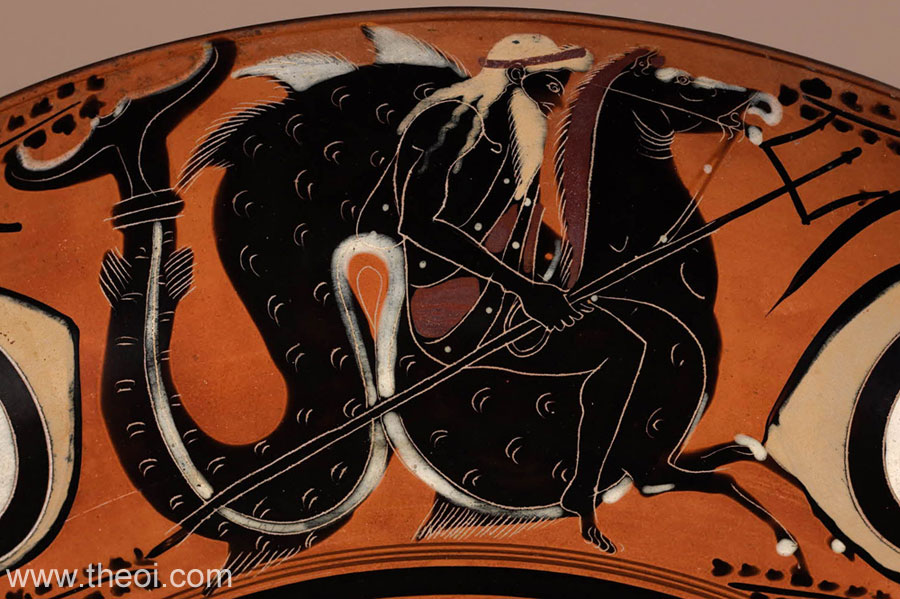
ANCIENT GREEK & ROMAN ART
SOURCES
GREEK
- Apollonius Rhodius, The Argonautica - Greek Epic C3rd B.C.
- Strabo, Geography - Greek Geography C1st B.C. - C1st A.D.
- Pausanias, Description of Greece - Greek Travelogue C2nd A.D.
- Philostratus the Elder, Imagines - Greek Rhetoric C3rd A.D.
ROMAN
- Valerius Flaccus, The Argonautica - Latin Epic C1st A.D.
- Statius, Thebaid - Latin Epic C1st A.D.
- Statius, Achilleid - Latin Epic C1st A.D.
BIBLIOGRAPHY
A complete bibliography of the translations quoted on this page.
